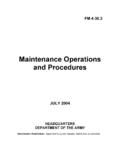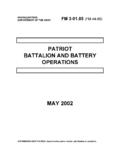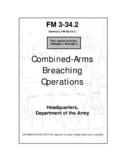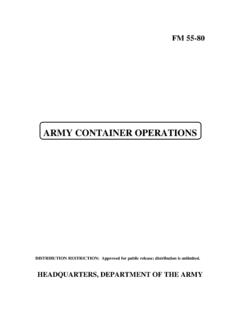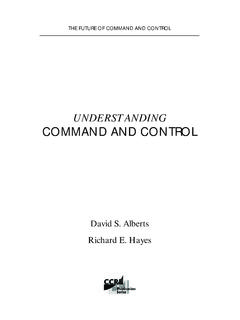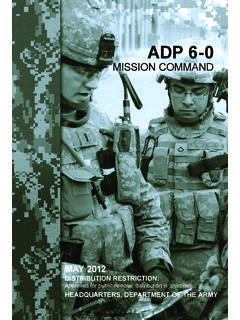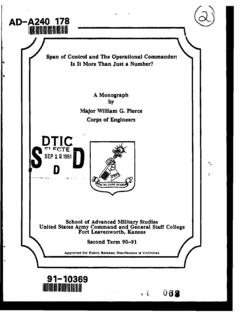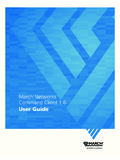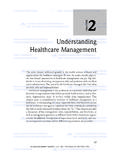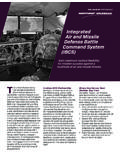Transcription of Mission Command: Command and Control of Army …
1 Mission Command : Command and Control of Army Forces FM 6-0 HEADQUARTERSDEPARTMENT OF THE ARMY DISTRIBUTION RESTRICTION:Approved for public release, distribution is unlimitedAUGUST 2003 Distribution Restriction: Approved for public release; distribution is unlimited. _____ *This publication replaces the following portions of FM 101-5, 31 May 1997: Chapters 1 4 and 6, and Appendixes G and I through L. i *FM 6-0 Field Manual Headquarters No. 6-0 Department of the Army Washington, DC, 11 August 2003 Mission Command : Command and Control of Army Forces Contents Page v viii x Chapter 1 Command AND Control Nature of Command and Control .
2 1-1 Environment of Command and Control .. 1-8 Concept of Command and Control .. 1-14 Historical Vignette Chancellorsville .. 1-21 Conclusion ..1-24 Chapter 2 2-1 Nature of 2-1 Art of Command ..2-13 Historical Vignette The Ruhr Encirclement ..2-30 Conclusion ..2-32 Chapter 3 3-1 Nature of 3-1 Science of 3-9 Historical Vignette The Battle of 3-24 Conclusion ..3-27 Chapter 4 THE ROLE OF THE 4-0 Combining the Art of Command and Science of 4-0 FM 6-0 _____ ii Creating a Positive Command Climate .. 4-15 Training Subordinates in Command and Control ..4-20 Battle Command ..4-24 Conclusion ..4-30 Chapter 5 THE Command AND Control 5-1 5-1 5-5 Information 5-10 5-19 Equipment and 5-21 Organization for Command and 5-22 Command Post.
3 5-27 Continuity of Command and Control .. 5-28 Conclusion ..5-29 Chapter 6 EXERCISING Command AND 6-1 Section I 6-1 Section II 6-4 Monitoring ..6-4 Evaluating .. 6-5 Section III 6-9 Planning 6-9 Assessment During 6-11 Planning Procedures ..6-11 Orders and Section IV 6-12 Assessment During 6-13 Reconnaissance 6-13 Security 6-14 Force Protection .. 6-14 Revising and Refining the Plan ..6-14 Coordination and 6-15 6-16 Task Organizing .. 6-17 6-17 Troop 6-17 Preoperation Checks and Logistic 6-18 _____ Contents iii Integrating New Soldiers and Section V 6-18 Execution 6-19 Assessment During Execution .. 6-20 6-23 6-29 Section VI 6-32 Appendix A THE OBSERVE-ORIENT-DECIDE-ACT Appendix B Cognitive Relevant Information Subject Categories Relevant Information Usage Categories.
4 B-12 Information Management Categories ..B-14 Relevant Information Quality Criteria ..B-17 Appendix C STAFF ORGANIZATION AND STAFF C-0 Basis for Staff Organizations ..C-0 Factors Affecting Staff Organizations ..C-1 Authorization for Staff Organizations ..C-1 Basic Staff C-2 Staff Models .. C-5 Characteristics of a Staff Officer .. C-6 Appendix D STAFF RESPONSIBILITIES AND D-1 Common Staff Activities, Responsibilities, and D-2 Specific Staff Responsibilities and Appendix E Liaison Fundamentals ..E-0 The Liaison Officer ..E-1 Liaison Liaison Practices ..E-2 Liaison Liaison in During Unified Action ..E-7 Appendix F Rehearsal Types ..F-2 Rehearsal Techniques ..F-3 Rehearsal Conducting a FM 6-0 _____ iv SOURCE Source Notes-0 Glossary-1 Bibliography-1 v Figures Figure Page 1-1.
5 Command and 1-2 1-2. The Operations Process .. 1-8 1-3. The Thought 1-9 1-4. Concepts of Command and 2-1. 2-2. Commander s 2-16 3-1. Control ..3-3 3-2. Functions of the Command and Control 3-4 3-3. Processing Information .. 3-14 4-1. Visualize, Describe, Direct, Lead ..4-1 4-2. Situational Understanding Over Time (Ideal).. 4-3 4-3. Developing Situational 4-4. Visualization in 4-5. Visualization and Describing .. 4-7 4-6. Visualization in Execution ..4-13 4-7. Adjustments During Execution ..4-14 5-1. Elements of the Command and Control 5-2 5-2. Information and the Command and Control 5-3 6-1. Distribution of Operations Process 6-2 6-2. Operations Process Supporting Topics.
6 6-3 6-3. Recognition of Variances .. 6-6 6-4. Restoring the Common Operational 6-7 6-5. Decisionmaking During Execution .. 6-20 6-6. Adjustment Decision 6-7. Decision Types and Related Actions ..6-30 6-8. Planning Future Operations ..6-32 A-1. The OODA Cycle ..A-1 B-1. Cognitive Hierarchy ..B-0 B-2. Relevant Information Production and B-3. Information Requirements and the Cognitive C-1. Basic Staff Structure .. C-2 C-2. Basic Corps or Division Staff C-4 C-3. Basic Smaller-unit Staff Structure (Brigade and Battalion).. C-5 Figures_____ vi D-1. Coordinating Staff Responsibility for Special Staff Officers ..D-26 E-1. Senior Liaison Officer Rank by E-1 E-2. Example Outline of a Liaison Officer E-3 E-3.
7 Liaison Checklist Before Departing the Sending E-5 E-4. Liaison Duties During the Liaison E-6 E-5. Liaison Duties After the Liaison E-7 F-1. Rehearsal Techniques Relative to Time, Resources, OPSEC, Participation, and Understanding .. F-4 F-2. Example CS and CSS Actions for F-14 Historical Vignettes Page The Battle Of Arbela (331 BC) ..vii Von Moltke and Command and Control at Command Based on Trust and Mutual Understanding Grant s Orders to Sherman, Calculated Risk or Military Gamble? Operation HAWTHORNE, Dak To, Resolve Mustafa Kemal at Obstinacy Frederick the Great at Establishing and Using Commander s Intent VII Corps and the Ruhr Crosstalk in the Desert VII Corps in the Gulf Control in Command and Control Magnificent, But Not War Misunderstood Orders and the Charge of the Light Command Forward LTG Eichelberger At Maps Map Page Introduction-1.
8 Arbela Initial Introduction-2. Arbela Alexander s 1-1. Chancellorsville Hooker s 1-2. Chancellorsville Lee s Counter ..1-23 2-1. 2-2. 2-3. Ruhr 3-1. Austerlitz Initial 3-2. Austerlitz 4-1. vii Preface Doctrine provides military organizations with a common philosophy and lan-guage. It enhances unity of effort. FM 6-0 establishes and explains the Army s Command and Control (C2) doctrine principles. PURPOSE FM 6-0 is the Army s key integrating manual for C2. It provides the basis for C2 doctrine, tactics, techniques, and procedures in all Army publications. It promotes common understanding of the fundamentals and concepts of C2 in Army operations, and supports joint and Army doctrine.
9 It supercedes chapters 1 through 4, chapter 6, and appendixes G, I, K, and L of FM 101-5. SCOPE FM 6-0 provides doctrine on C2 for tactical Army echelons (corps and below). FM 6-0 establishes Mission Command as the C2 concept for the Army. It focuses on the premise that commanders exercise C2 over forces to accomplish missions. It emphasizes fundamentals and concepts rather than specific equipment or sys-tems, although it discusses the role of equipment and systems in supporting C2. It includes insights from Force XXI initiatives and digitization. Supporting and extending leadership doctrine found in FM 22-100, it defines Control within com-mand and Control , and covers decisionmaking during execution.
10 FM 6-0 provides doctrine for information management, a contributor to information superiority. (See FM 3-13.) While intelligence is an information product essential in C2, the doctrine addressing information and information management is not intended to change or replace intelligence doctrine in the FM 2 (formerly FM 34) series of field manuals. APPLICABILITY FM 6-0 applies to commanders of all Army organizations. However, it focuses on tactical commanders and leaders at corps-level and below. With appropriate modifications, it can apply to other Army commands and to Army elements of joint and multinational headquarters. It applies to digitized, analog, and hybrid (combination digitized/analog) units and organizations.


